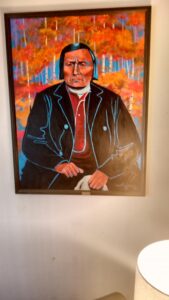Santee Sioux Gospel Music – Saving the language
Santee Sioux Gospel Music – Saving the language
By Clara Caufield,
NSNT Correspondent
This segment of the Language Preservation Series was suggested and explained by Jim James, Santee Sioux, Nebraska, former tribal chairman, one of the tribal historians and acclaimed singer of translated Sioux gospel songs. “Gospel songs translated into our language has been going on for about 140 years,” he recounted.
This historical and oral account has roots in the Santee Sioux Rebellion of 1862, as told by James a direct descendent of Hus’sa, Red Legs (pronounced Hoo-sha-sha); a Santee Chief who participated in that uprising, which had disastrous results for the Santee Sioux.
Hus’sa was the great great-grandfather of Jim James, on the maternal side.
After defeat, thirty-eight of the rebellion leaders were hanged in 1862 in what has come to be regarded as one of the worst atrocities committed against the Great Plains Tribes by the U.S. government.
Those captives were provided the opportunity for reprieve if only they would recant traditional ways and religion and become baptized.
Hus’sa, a Santee Chief, traditional healer saw the handwriting on the law and agreed, baptized in prison by an Episcopalian Bishop Benjamin Whipple for whom he was renamed.
After reprieve, Hus‘sa continued in a leadership role, becoming a sincere Episcopalian, advising that the best hope for survival of the Santee was assimilation – learning to adapt and walk the white man’s road.
The Santee Sioux were forcibly removed from Minnesota to Nebraska, their current reservation, established in 1863.
Then, as happened to so many other Tribes, traditional religious ceremonies and use of the Santee Sioux dialect was outlawed by the Federal Government. The consequences were severe for those who persisted in following the old ways in violation of that mandate.
Hus’sa and other elders were, as James says “brilliant” in thinking about how to preserve the language. They approached the Episcopalian Biship, asking if it might be acceptable to translate Christian gospel songs into the Santee language. The Bishop agreed that would not be a sin. Over the years, a group of dedicated Santee speakers worked on that project resulting in the production of a hymnal Wakan Cekiya (Holy Hymnal) by the All Most Merciful Savior Church, the first Christian church in Dakota Territory.
In 1893, William H. Hare, Missionary Bishop of South Dakota forward the following letter to the Missionary District of South Dakota, Hymnal Language Committee stating in part:
The comfort and help which the Dakotas find in the hymns and music of the Church are so great and their enjoyment of them is so rich that I welcome the announcement of the completion of your work and rejoice that is coincides with the anniversary of the death of the beloved brother who sympathized so keenly with his people in their need and in their love of sacred music.
The publication of the tune book is hereby authorized with grateful acknowledgment of your labors.
As listed in the hymnal, over the years, may Santee authors and translators were active in making the Wakan Cekiya, Odowan hymnal possible: Andrew jones; Charles S. Cook; Charles W. Hoffman; Daniel W. Hemans; George Dowanna; George St. Clair; Henry Swift; John B. Chapman; Joseph C. Taylor; James Hemans; Joseph W. Cook; T. Kicosmani Taylor; Luke C. Walker; Philip Johnson; Pierre La Pointe; Paul Maxakute; Philip Weston; Samueul D. Himan; Thomas Wakanna; William Holmes; William J. Cleveland; Willam M Robetson; Walter S. Hall; and William T. Selwyn.
Thus arose a group of Santee gospel singers delivering those tunes in the Lakota language. Jim James recalls growing up in an Episcopalian family of gospel singers and musicians who were requested to travel, especially for funerals, memorials and related services. He started singing in that group at the age of ten and has special memory of his sisters who also sang, Meridith DeCory and Marylin Damion James, who attended boarding school and sang locally. Marilyn went to work in the Lincoln health department while Meridith worked for the BN Railroad for decades, one the first Native Americans to serve as Miss South Dakota in 1963. (That will merit another future story).
Now in his seventies, retired and living in Lincoln, Nebraska to be near his children, Jim James is still singing Sioux gospel songs, often accompanied by his daughter Tonya, organist. “I’m teaching others the songs,” he explained. “Even non-Indians who want to learn. I am not a fluent speaker, but I know and can properly pronounce all the words in the gospel hymns. Those were wise old men, figuring out how to save our language through gospel. It has been going on for about 140 years and we do not intend to stop.”
(Clara Caufield can be reached at acheyennevoice@gmail.com)
The post Santee Sioux Gospel Music – Saving the language first appeared on Native Sun News Today.

